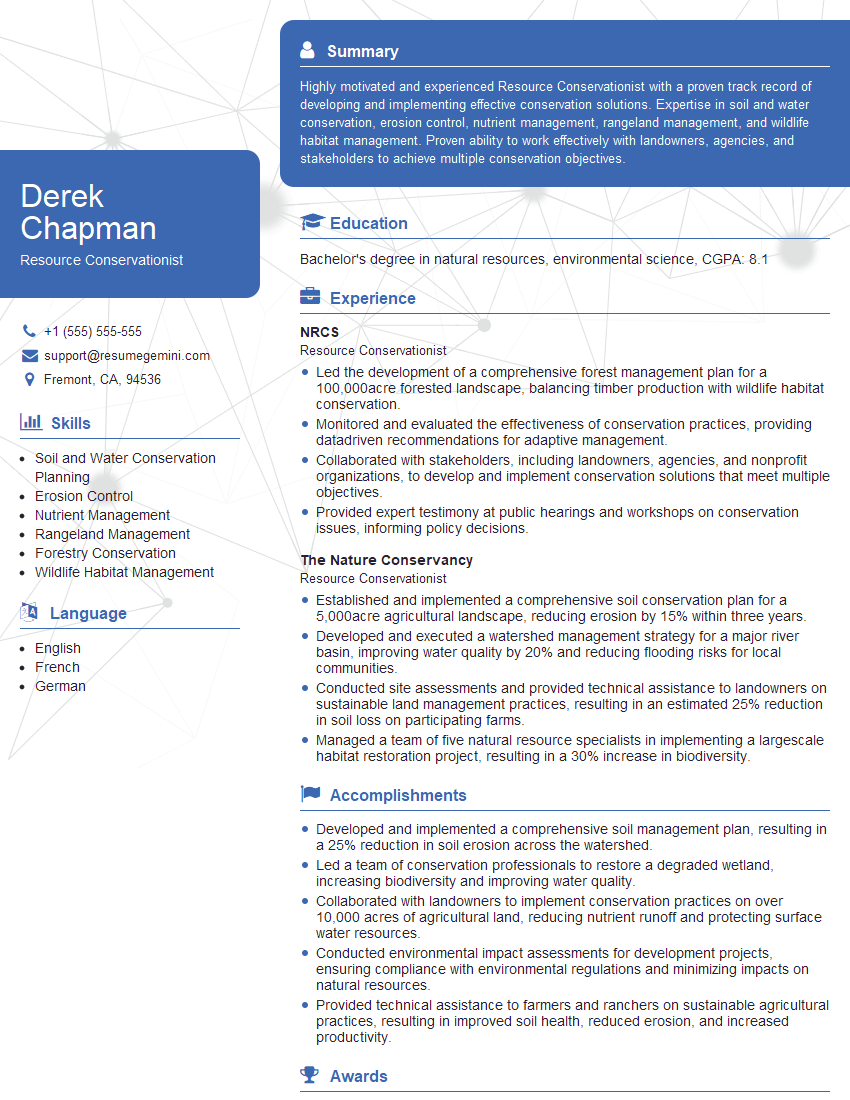Are you a seasoned Resource Conservationist seeking a new career path? Discover our professionally built Resource Conservationist Resume Template. This time-saving tool provides a solid foundation for your job search. Simply click “Edit Resume” to customize it with your unique experiences and achievements. Customize fonts and colors to match your personal style and increase your chances of landing your dream job. Explore more Resume Templates for additional options.

Derek Chapman
Resource Conservationist
Summary
Highly motivated and experienced Resource Conservationist with a proven track record of developing and implementing effective conservation solutions. Expertise in soil and water conservation, erosion control, nutrient management, rangeland management, and wildlife habitat management. Proven ability to work effectively with landowners, agencies, and stakeholders to achieve multiple conservation objectives.
Education
Bachelor’s degree in natural resources, environmental science
April 2015
Skills
- Soil and Water Conservation Planning
- Erosion Control
- Nutrient Management
- Rangeland Management
- Forestry Conservation
- Wildlife Habitat Management
Work Experience
Resource Conservationist
- Led the development of a comprehensive forest management plan for a 100,000acre forested landscape, balancing timber production with wildlife habitat conservation.
- Monitored and evaluated the effectiveness of conservation practices, providing datadriven recommendations for adaptive management.
- Collaborated with stakeholders, including landowners, agencies, and nonprofit organizations, to develop and implement conservation solutions that meet multiple objectives.
- Provided expert testimony at public hearings and workshops on conservation issues, informing policy decisions.
Resource Conservationist
- Established and implemented a comprehensive soil conservation plan for a 5,000acre agricultural landscape, reducing erosion by 15% within three years.
- Developed and executed a watershed management strategy for a major river basin, improving water quality by 20% and reducing flooding risks for local communities.
- Conducted site assessments and provided technical assistance to landowners on sustainable land management practices, resulting in an estimated 25% reduction in soil loss on participating farms.
- Managed a team of five natural resource specialists in implementing a largescale habitat restoration project, resulting in a 30% increase in biodiversity.
Accomplishments
- Developed and implemented a comprehensive soil management plan, resulting in a 25% reduction in soil erosion across the watershed.
- Led a team of conservation professionals to restore a degraded wetland, increasing biodiversity and improving water quality.
- Collaborated with landowners to implement conservation practices on over 10,000 acres of agricultural land, reducing nutrient runoff and protecting surface water resources.
- Conducted environmental impact assessments for development projects, ensuring compliance with environmental regulations and minimizing impacts on natural resources.
- Provided technical assistance to farmers and ranchers on sustainable agricultural practices, resulting in improved soil health, reduced erosion, and increased productivity.
Awards
- Excellence Award for Soil and Water Conservation Management, recognized by [Organization]
- Environmental Stewardship Award for Sustainable Land Use Practices, presented by [Agency]
- Partnership Award for Collaboration in Watershed Restoration, received from [Institution]
Certificates
- Certified Professional Soil Scientist (CPSS)
- Certified Erosion and Sediment Control Professional (CESCP)
- Certified Nutrient Management Specialist (CNMS)
- Certified Rangeland Manager (CRM)
Career Expert Tips:
- Select the ideal resume template to showcase your professional experience effectively.
- Master the art of resume writing to highlight your unique qualifications and achievements.
- Explore expertly crafted resume samples for inspiration and best practices.
- Build your best resume for free this new year with ResumeGemini. Enjoy exclusive discounts on ATS optimized resume templates.
How To Write Resume For Resource Conservationist
- Highlight your experience in developing and implementing conservation plans that have achieved measurable results.
- Demonstrate your understanding of the principles of soil and water conservation, erosion control, and nutrient management.
- Showcase your ability to work effectively with landowners, agencies, and stakeholders to achieve conservation goals.
- Emphasize your commitment to environmental stewardship and your passion for protecting natural resources.
Essential Experience Highlights for a Strong Resource Conservationist Resume
- Plan and implement soil and water conservation practices to reduce erosion and improve water quality
- Develop and execute watershed management strategies to address flooding and water scarcity issues
- Provide technical assistance to landowners on sustainable land management practices
- Manage teams of natural resource specialists in implementing conservation projects
- Monitor and evaluate the effectiveness of conservation practices and provide recommendations for adaptive management
- Collaborate with stakeholders to develop and implement conservation solutions that meet multiple objectives
- Provide expert testimony at public hearings and workshops on conservation issues
Frequently Asked Questions (FAQ’s) For Resource Conservationist
What are the primary responsibilities of a Resource Conservationist?
Resource Conservationists are responsible for planning and implementing conservation practices to protect and improve natural resources. They work with landowners, agencies, and stakeholders to develop and implement conservation solutions that address issues such as soil erosion, water quality, and wildlife habitat loss.
What are the educational requirements for becoming a Resource Conservationist?
Most Resource Conservationists have a bachelor’s degree in natural resources, environmental science, or a related field. Some employers may also require experience in conservation planning and implementation.
What is the job outlook for Resource Conservationists?
The job outlook for Resource Conservationists is expected to be good over the next decade. Growing concerns about environmental issues and the need for sustainable land management practices are driving demand for qualified professionals.
What are the key skills and qualities of a successful Resource Conservationist?
Successful Resource Conservationists typically have a strong understanding of soil and water conservation, erosion control, and nutrient management. They are also effective communicators and collaborators, and have a passion for protecting natural resources.
What are the career advancement opportunities for Resource Conservationists?
Resource Conservationists can advance their careers by taking on leadership roles in conservation organizations, government agencies, or the private sector. They may also specialize in a particular area of conservation, such as soil and water conservation or wildlife habitat management.